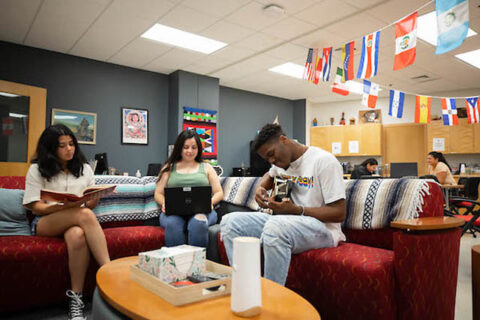 Clarksville, TN – For Kemeliz Fuentes, a sophomore at Austin Peay State University (APSU), being a Latina in America often means struggling to exist in two separate worlds.
Clarksville, TN – For Kemeliz Fuentes, a sophomore at Austin Peay State University (APSU), being a Latina in America often means struggling to exist in two separate worlds.
“You’ll ask yourself, ‘Am I being American enough for my American friends and Hispanic enough for my Hispanic friends?’” she said.

When these questions begin to overwhelm her, Fuentes heads to the bottom floor of the APSU Morgan University Center where, in a large office suite with couches, tables, a television, and a small kitchen area, she relaxes with friends dealing with similar concerns.
This space, the APSU Latino Community Resource Center, is a second home for students like Fuentes, and it’s helping more Latino students enroll and thrive at Austin Peay.
“I like it here because I can feel more connected to who I am,” she said. “For me, it provides a sense of community to connect more with my people.”
Last year, Kiah Albritton with the Education Trust of Tennessee noted that Latino Tennesseans “are largely underrepresented at many of our state’s public higher education institutions.” The Trust released a report – “Tennessee: Segregation Forever?” – that criticized several Tennessee schools for their inclusion efforts, but the document also praised Austin Peay for its recruitment and retention of Latino students.
“Alongside the overall growth, [Austin Peay] has maintained a focus on increasing its student of color population as well,” the report stated. “The campus, which has the highest Latino access score of any public institution in the state, also enrolls more military students than all other state colleges and universities combined. One strategy in achieving the institution’s goals to increase diversity is clearly stating, prioritizing, and investing resources to meet that goal.”
In recent years, the center has become one of the key instruments in that strategy, which is why the University rebranded it this spring from the Hispanic Cultural Center – as it was known for 16 years – to the Latino Community Resource Center (LCRC).
“When we were the Hispanic Cultural Center, I think there was always this confusion of what we were and who we served,” Yanaraliz Barnes, coordinator for the center, said. “A lot of people thought we were a club, or they thought we primarily provided tutoring for people taking Spanish, and some didn’t even know we were here. We wanted to be more specific, more upfront about what’s our main focus, which is to serve Latino students through resources. And so, we are now the Latino Community Resource Center.”
Barnes also wanted to move away from the word “Hispanic,” which she said limited the center’s mission of inclusivity.
“Hispanic refers to language, and Latino refers to area,” she said. “While Spanish is the most spoken language in Latin American and the Caribbean, it is not the only language spoken. Indigenous languages, Portuguese, English, German, Italian, amongst other languages are also spoken in this region. We changed the name just to be more inclusive about the different communities in the region.”
Today, the LCRC offers new, resource-based programs that help students succeed in their college careers. Those programs include FAFSA 101 sessions, peer tutoring in English and mathematics, meetings with career services, and group counseling sessions. The center also lends students laptop computers and graphic calculators each semester, and it provides quiet study rooms, a lounge with a television, and free coffee.
“I’m a graduate student and I still come regularly,” Ana Pla Rosario said. “I come because of the people and workers. It’s a very comfortable place for me. I feel like I don’t have a reason to come, I just come.”
Pla Rosario first visited the center about two years ago, and after talking in Spanish with Barnes, she knew she’d found a place where she could feel at home.
“I was very excited there was a professional in the University who spoke Spanish and was here for us,” she said. “I thought it was only for other people to learn about the culture, but now I feel like it’s definitely taking a turn for serving the community as a resource center.”
The center is also taking a more active role in recruiting Latino students to APSU. Last spring, it hosted its inaugural Día de Visita for potential students.
“It’s similar to AP Day but completely in Spanish,” Barnes said. “It’s family-oriented and we go over applications and how to submit a FAFSA. We gave tours of the institution in Spanish, and we have assistants at the end if anyone needs help. Sometimes, parents aren’t familiar with the process – we have a lot of first-generation students – so this event includes the entire family.”
Once the students enroll at APSU, Barnes also wants them to quickly feel at home. That’s why the center is also offering its Latino Student Retreat: Ponte Las Pilas from 10 a.m-2 p.m. on Saturday, August 28th.
“I want them to connect to each other and connect with their community,” she said. “I want them to learn how to get involved and make the most of their time at APSU. It’s free, they’ll get breakfast and lunch, a center shirt, and we’ll have $500 worth of prizes. It’s for both incoming and existing Latino students.”
For information on the LCRC, visit https://www.apsu.edu/student-life/lcrc/.



